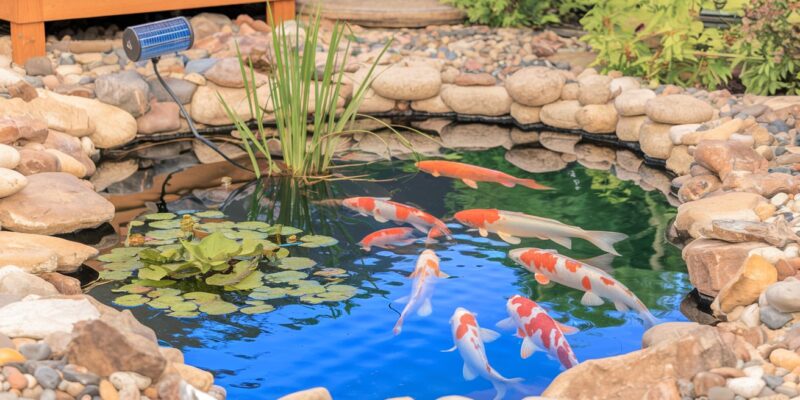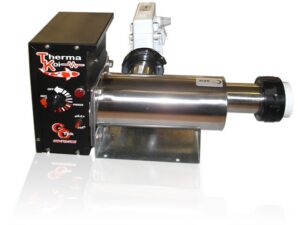
A beautiful pond can be the heart of a garden, especially when it’s teeming with vibrant aquatic life. However, as the colder months approach, maintaining the health and balance of your pond requires some special attention. One essential tool in the pond caretaker’s arsenal is the Pond Heater. Whether it’s protecting fish from icy temperatures or ensuring that plants thrive year-round, a pond heater is a vital addition to any pond. In this guide, we’ll explore why pond heaters are a must for pond owners, what to look for when choosing one, and how they contribute to the well-being of your aquatic ecosystem.
Why Your Pond Needs a Heater: Beyond Just Fish
When the temperature drops, many assume that a pond will naturally freeze and enter a state of dormancy. While that may work for certain bodies of water, most ponds—especially those designed for koi or other sensitive species—need a little help to maintain an optimal environment. A pond heater ensures that water temperatures remain stable, preventing ice from forming across the entire surface.
The primary concern for most pond owners is, of course, the health of their fish. Koi, for example, thrive in temperatures between 59°F and 77°F (15°C to 25°C). If temperatures drop too low, the metabolism of these fish slows down, which can lead to stress or, worse, illness. More dangerously, ice that completely covers a pond can trap harmful gases like ammonia and carbon dioxide, leading to poor water quality. Pond heaters can keep an opening in the ice, allowing these gases to escape, which is essential for the health of the pond.
But the benefits don’t stop there. A pond heater also protects the overall aquatic ecosystem. From beneficial bacteria that help break down waste to plant life that depends on specific temperatures, a heater ensures that all living organisms in the pond can thrive, even in colder climates.
Choosing the Right Pond Heater: What to Consider
Not all pond heaters are created equal, and choosing the right one involves more than simply selecting a heater with the highest wattage. Several factors should be considered to ensure you’re getting the right fit for your pond.
First, it’s essential to assess the size of the pond. Larger ponds naturally require more powerful heaters to maintain a stable temperature. The heater needs to cover enough surface area to keep the water open and prevent ice from completely forming.
Another consideration is the type of heater. There are floating heaters that rest on the surface, which are ideal for maintaining an opening in the ice. For those looking for a more advanced system, in-line heaters that connect directly to the filtration system provide more comprehensive temperature control, warming water as it passes through the filter.
Reliability is also a key factor. Pond heaters need to operate efficiently throughout the winter, so investing in a quality unit is essential. Companies like Aquabead offer an array of pond solutions, including heaters designed for larger, commercial-sized ponds. Whether for a backyard water garden or a vast koi pond, Aquabead’s equipment ensures consistent temperature control to keep aquatic environments healthy.
Installation Tips for Pond Heaters
Installing a pond heater can seem intimidating at first, but with the right preparation, it can be a straightforward process. One of the first steps is to ensure that your heater is appropriately sized for your pond. Overloading a small heater with a large pond could result in inefficient heating and even damage the unit over time.
Next, consider the placement of the heater. For floating heaters, it’s critical to position them in an area that will allow sufficient water circulation. This ensures the heat is evenly distributed across the pond, preventing localized cold spots. For in-line heaters, installation within the filtration system is key. Many pond owners opt to integrate these heaters with high-quality filters, such as those from Aquabead, which offers reliable pond and water garden filtration systems.
It’s also essential to monitor the heater’s operation throughout the season. Some heaters come with automatic shut-offs to prevent overheating, but regular checks are recommended to ensure everything is functioning properly.

Year-Round Pond Care: Beyond Just Heating
While a pond heater is a fantastic tool for maintaining a healthy aquatic environment during winter, it’s important to remember that year-round care is essential. A well-maintained pond filter system is crucial for keeping water clean and clear, no matter the season. Filters, such as those offered by Aquabead, ensure that debris and waste products are efficiently removed, preventing water quality from deteriorating.
Beyond heating and filtration, pond owners should also invest in a good-quality pond pump. These pumps help circulate water, oxygenating the pond and ensuring that aquatic life remains healthy. Again, Aquabead offers a range of pond pumps suitable for commercial use or larger water features, ensuring reliable performance even in the most demanding conditions.
Pond maintenance is a balancing act, especially when it comes to larger or more complex setups. While heating is a significant factor during the colder months, it’s just one part of maintaining a thriving pond ecosystem. Regular water testing, ensuring proper filtration, and managing debris are all vital tasks that shouldn’t be neglected.
Maintaining Your Pond Heater for Long-Term Use
Like any piece of equipment, pond heaters require regular maintenance to ensure they last for many years. One of the easiest ways to maintain a pond heater is by periodically cleaning it. Over time, algae and other debris can accumulate on the surface of the heater, reducing its efficiency.
When cleaning the heater, it’s essential to follow the manufacturer’s guidelines. Most heaters can be wiped down with a soft cloth, but harsh chemicals or abrasive materials should be avoided. If the heater is part of a more extensive filtration system, it may be worth consulting professionals, such as those from Aquabead, who are experienced in the maintenance of pond equipment.
Finally, at the end of the cold season, storing the heater correctly is essential. For floating heaters, this may involve draining any water that has accumulated inside and storing it in a dry location. In-line heaters may need to be disconnected from the filtration system, drained, and properly stored until the next winter season.
A Warm Pond is a Happy Pond
Pond heaters are an essential investment for any pond owner, providing warmth and stability during the colder months. While they are most commonly associated with keeping fish like koi healthy, they also play a crucial role in maintaining the overall ecosystem of the pond, from plants to beneficial bacteria.
By carefully selecting the right heater, properly installing and maintaining it, and using complementary products like filters and pumps, pond owners can create a balanced, thriving environment. For those looking for top-quality pond supplies, offers a range of heaters, filters, and pumps designed to keep ponds of all sizes functioning at their best year-round.
Why Choose Grand Champion Technologies?
Grand Champion Technologies stands for quality and innovation and provides cutting-edge solutions across various industries. We customize products specifically to our client’s individual requirements for maximum efficiency, reliability and long-term value. Grand Champion Technologies (GC TEK) www.aquabead.com top priority is customer satisfaction. We pride ourselves on personalized support and seamlessly incorporating our technologies into your operations, while seamlessly integrating advanced equipment, high-quality software and comprehensive services into their operations.











